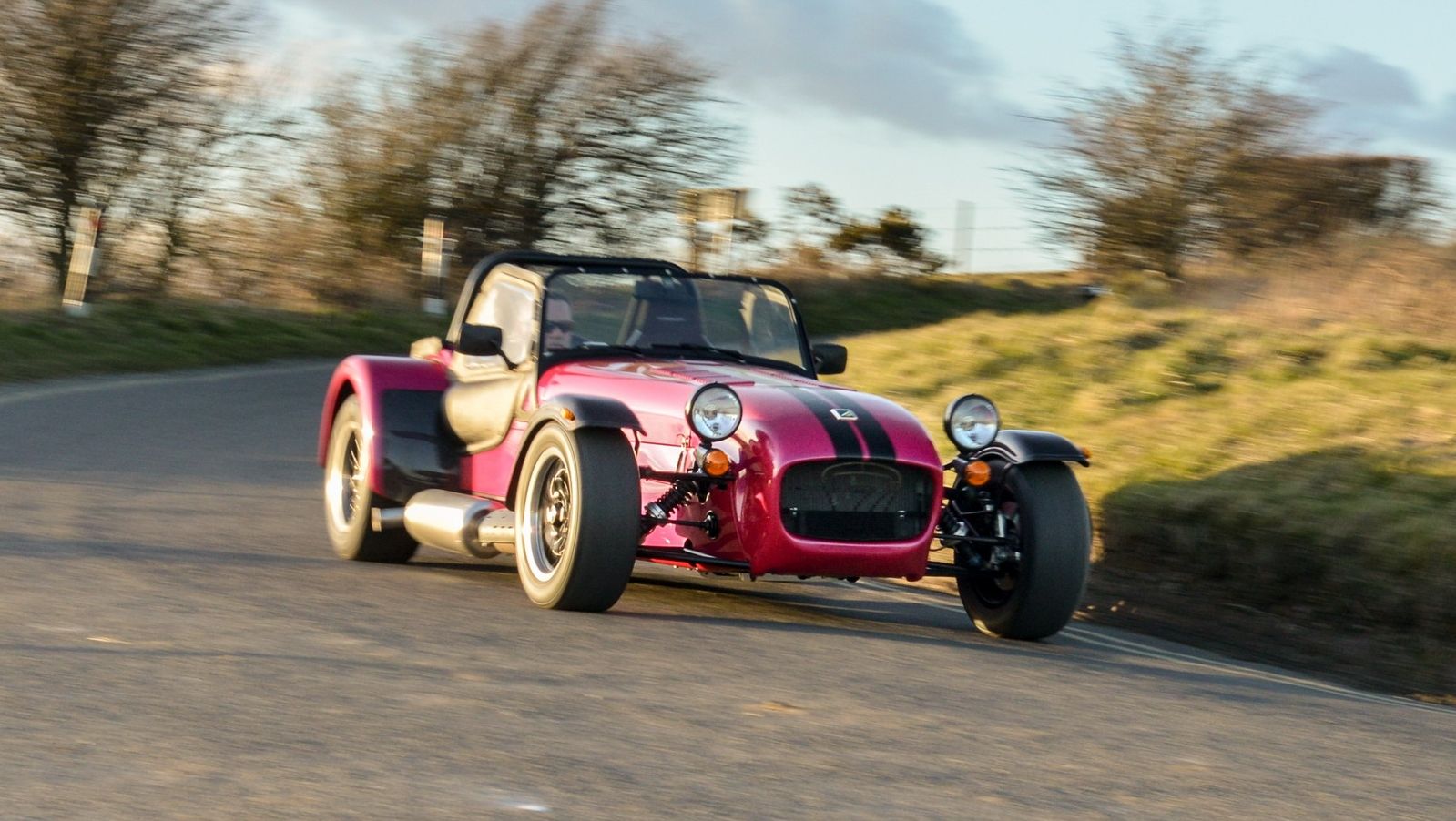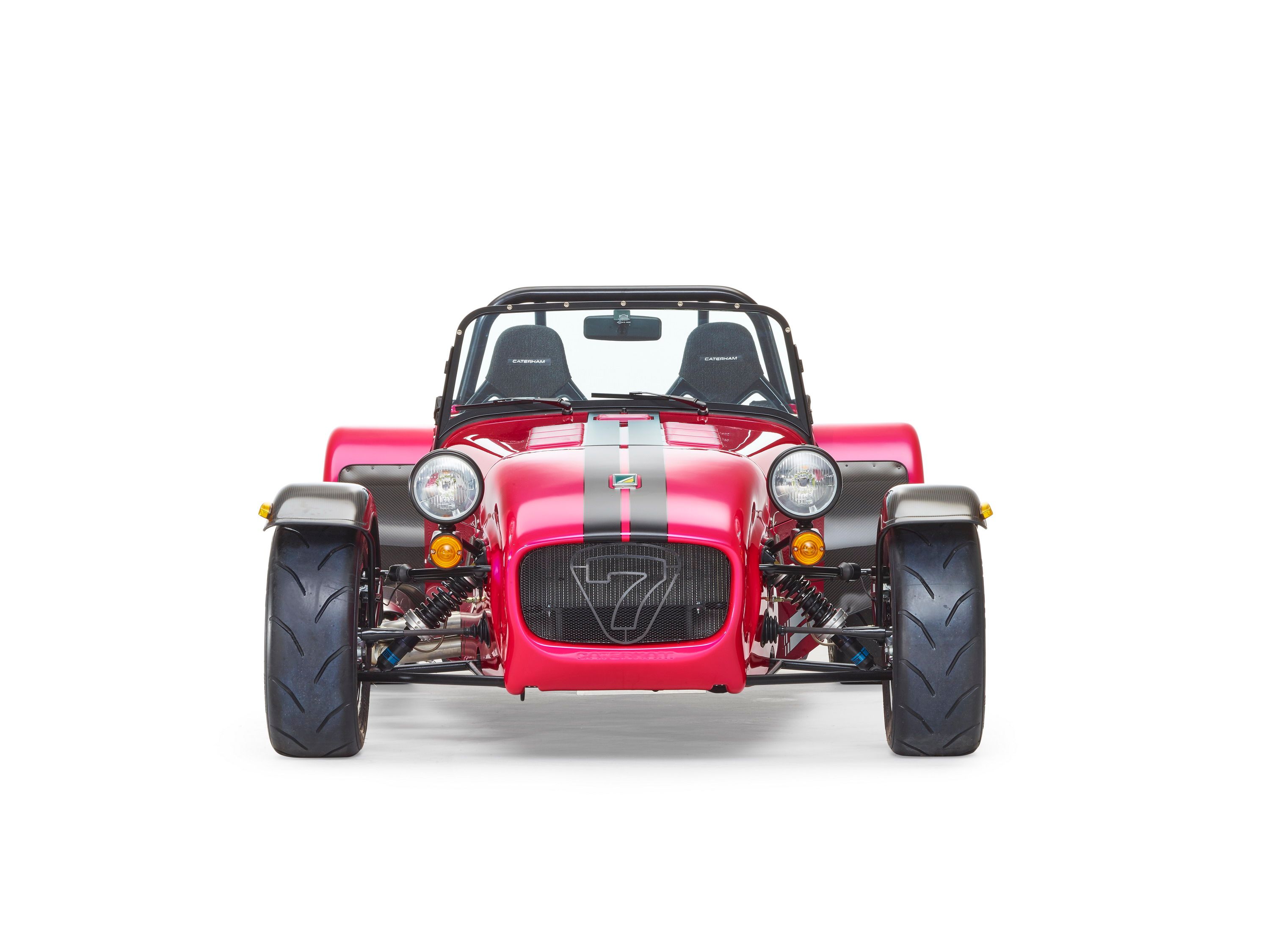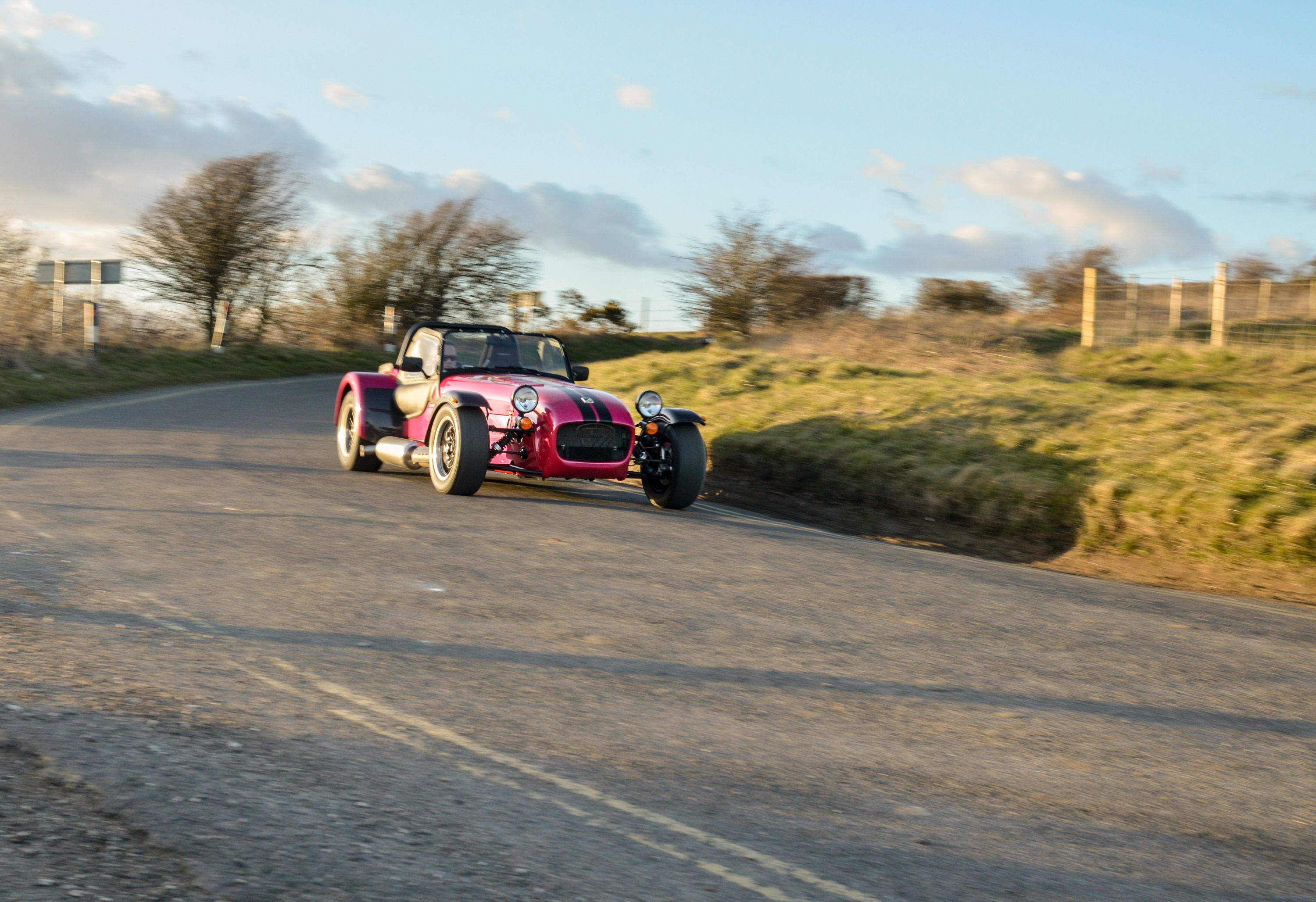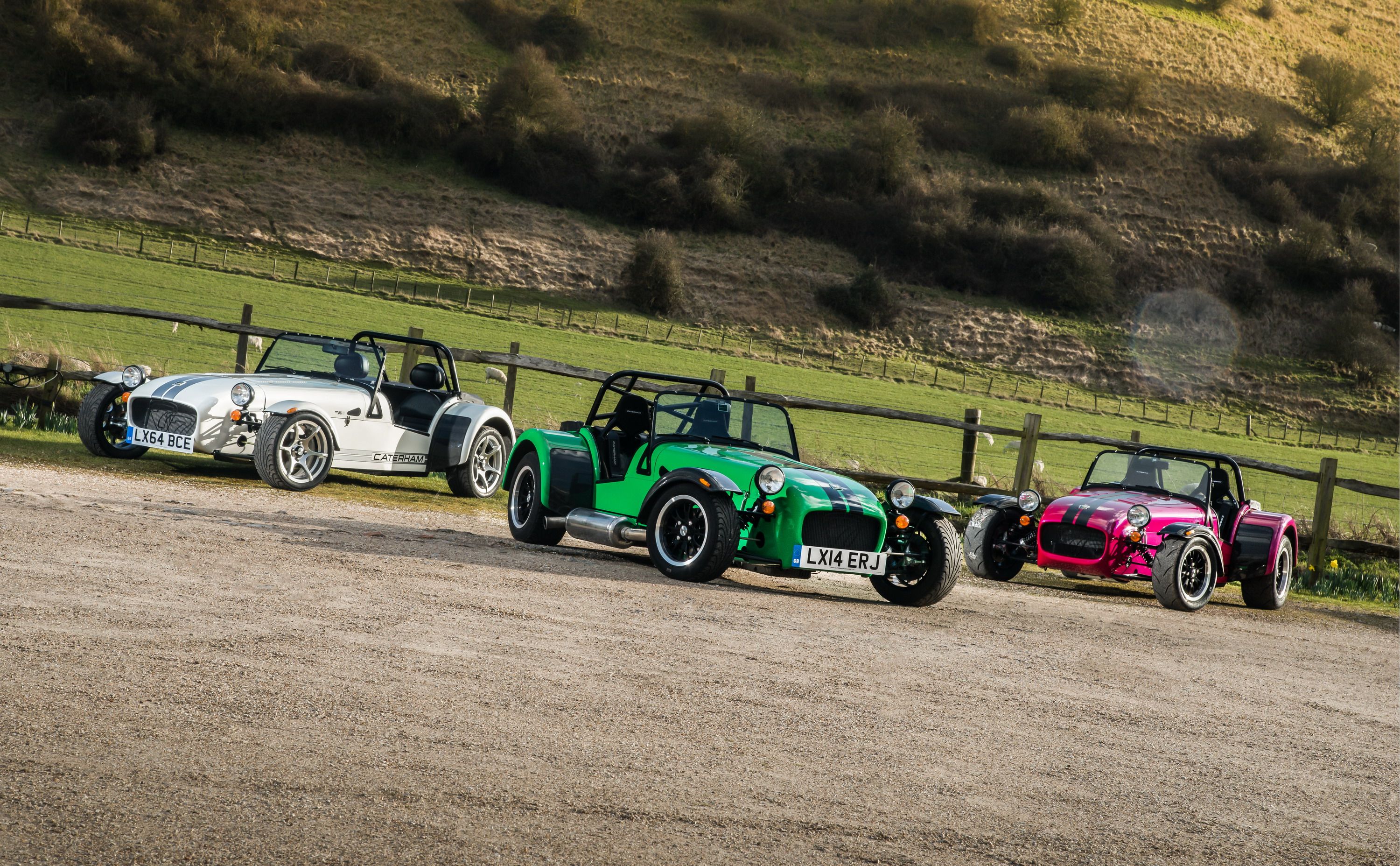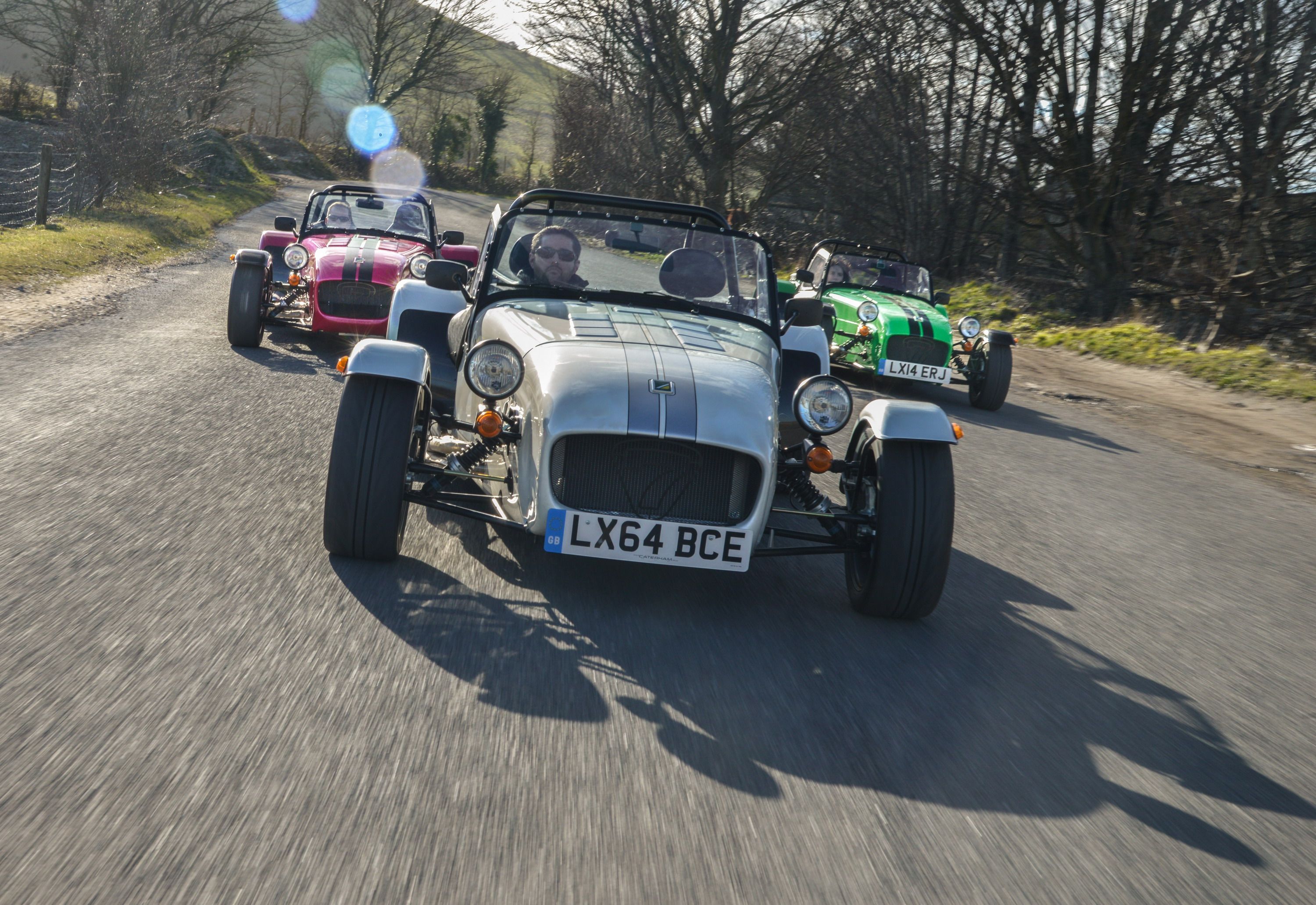Headquartered in Crawley, Sussex, British sports car manufacturer Caterham->ke1252 has made its iconic open-wheel racer, the Seven, since 1973. The original philosophy was simple: create a performance vehicle that was accessible, minimalistic, and most importantly, lightweight. As a continuation of that mantra, Caterham recently unveiled three new additions to its lineup, including the Seven 270, the Seven 360, and, pictured above, the Seven 420. All are currently available in the UK, and have optional “S” and “R” equipment packages specifically tailored for added streetability (“S”) or enhanced racing prowess (“R”).
The new models condense Caterham’s offerings to five core vehicles, with the pre-existing entry-level Seven 160 and supercharged 620R bookending the catalog. The 420 sits between the road-and-track-balanced 360 and the 620, offering more speed than the lesser models, while retaining decent drivability and accessibility. “While still being built around Colin Chapman’s ethos of ‘add lightness,’ the Seven 420 adds something else too… additional horsepower,” says Caterham.
Like the rest of the Seven model range, the base 420 strips out all “unnecessary comforts” to deliver “pure, unadulterated driving thrills.” It’s a formula that’s time-tested and competition-proven. However, even with its undeniable track record, one can’t help but think the design is getting a bit long in the tooth. So then – can the new model still deliver the goods, even in 2015?
Continue reading to learn more about the Caterham Seven 420.
2015 Caterham Seven 420
- Make: Array
- Model: 2015 Caterham Seven 420
- Engine/Motor: inline-4
- Horsepower: 210
Exterior
The 420 is instantly recognizable as a Caterham Seven, thanks to open wheels up front, no roof, no doors, long pointed hood, and a seating position that situates the driver directly adjacent to the rear axle. Bare suspension components, prominent exhaust pipes, and a feeling of “stripped-down and race-ready” pervades throughout. It’s a look that’s barely changed over the years, which makes sense given the car’s purely functional intentions.
All Caterhams come standard in an unpainted aluminum finish with colored fiberglass wings and nose. For a fee of £1,250 ($1,871, 3/23/15), you can get yours painted in one of six Caterham hues (yellow, blue, green, orange, black or red), or, for a little extra, you can request a custom color choice.
The 420 is available in either a standard or wide-bodied “SV” chassis. The standard chassis fits the same dimensions as in years past, while the SV increases interior and luggage room with added width and length, which should make it a bit more comfortable when trekking out to the more remote tracks, or if you happen to be of the taller persuasion. The wider track suspension also enhances handling stability, while the SV’s larger fuel tank increases range. Despite more space and extra stuff, the SV chassis sees only 55 extra pounds added to the curb weight.
Additional options include carbon-fiber rear wings, a carbon-fiber nose cone (unavailable on the SV), an aero filler cap, and the Black Pack, which replaces the chrome headlights and silver aluminum windshield frame with a matte black finish.
The S Pack throws in the aero filler cap and four paint options, while the R Pack incorporates the Black Pack, aero filler cap, and four paint options.
Interior
Traditionally, any feature that doesn’t shave tenths on the track has no place on the Seven. With that in mind, anyone bold enough to climb into one of the two seats in the 420 should expect to be met with little more than the pure, unadulterated sensations of a performance vehicle at speed. There’s no infotainment, no sound deadening, and no backside coddling. However, there are cloth adjustable seats, a Motolita steering wheel, and seat belts.
Caterham is offering a bit more refinement with the S Pack, and while it won’t turn the Seven into a Rolls-Royce,->ke74 it will make street duties relatively civilized (at least by Caterham standards). Equipment for the S Packs includes full interior carpeting, a full windscreen, hood and side screens, a heater, a black vinyl transmission tunnel cover, 12-volt socket, and even black leather seats. The pack also includesthrows in a Momo steering wheel, a new gearshift knob, and new instrumentation.
“Wow,” you might be thinking, “carpets and a windscreen big enough to deflect impromptu bug hors d’oeuvres? That’s way too bougie for me.” Well, don’t worry, because Caterham designed the R Pack for crazies just like you. Included are four-point race harnesses, a unique “R” tachometer optimized for use at high rpm, a carbon-fiber dashboard, composite racing seats, Momo steering wheel, and sequential shift lights.
Most of the equipment can be ordered a la carte if desired, while additional options include weatherproofing, four seat choices, lowered floors for both the driver and passenger, a carbon-leather transmission tunnel cover, plumbed-in fire extinguisher, a battery master cut-off switch, and three roll bar and cage choices.
Drivetrain
Under that elongated and louvered hood, you’ll find a Caterham-tuned, Ford->ke31 Duratec 2.0-liter four-cylinder engine producing 210 horsepower at 7,600 rpm and 203 pound-feet of torque at 6,300 rpm.
Now I know there’s more than a few of you out there that turn their noses up at such figures. If you happen to be one of those individuals, get ready to be schooled. You see, engine output is relative to the mass it motivates. While 210 horsepower is peanuts for a full-weight commuter, it’s more than enough for the 1,235-pound Seven 420. Top speed is 136 mph, but it’s the way this machine gets there that’s impressive. The power-to-weight ratio is 5.88 pounds per horsepower, which means it’ll hit 60 mph from a standstill in just 3.8 seconds.
Other standard equipment includes dry sump lubrication, a five-speed manual gearbox, rack and pinion steering, and “Classic” 8-spoke aluminum wheels measuring 6-inches in width and 14-inches in diameter. Making stick are 185/60 Avon tires. At-limit handling is facilitated by double wishbones and coil springs over Caterham Bilstein dampers up front, while a Dedion semi-independent suspension with radius arms and A-frame linkage sits out back. The brakes are twin circuit split front/rear, with discs at each corner.
The S Pack makes things more civilized with road-oriented suspension settings. The R Pack, predictably, takes the opposite path with a slew of extra go-faster bits. These include a limited-slip differential, sport-tuned suspension, a lightweight flywheel, an upgraded brake master cylinder and a rear anti-roll bar. Two wheel options are available, including 15-inch Orcus alloys designed by Caterham, which are 10 percent lighter than the 15-inch alloys, as well as a 13-inch alloy that takes advantage of an upgraded suspension geometry for “the ultimate in racetrack handling.”
Other options include a six-speed transmission, ventilated front discs with quad-piston calipers, six wheel and tire combinations, and a track day rear-exit exhaust system.
Prices
The base model Seven 420 starts at £26,995, or $40,367 at current conversion rates (3/23/15). The S Pack will tack on another £2,995 ($4,479), while the R Pack is £3,995 ($5,974).
Competition
Ariel Atom 3
Note: vehicle pictured is not current model.
Ariel->ke563 has more than a few things to say on the subject of brutally simple, lightweight, open-wheel speed machines. The Atom 3, for example, is the British marque’s entry-level sports car, coming in with a sticker price of about $65,000.
Mounted just inches behind the cockpit is a 2.4-liter K24 Honda->ke34 mengine laying down 230 horsepower. With a curb weight of just 1,350 pounds, this powerplant endows the Atom with a 0-to-60 time of under three seconds. The transmission is a close-ratio six-speed manual, which routes to a limited-slip differential in the back. The stock brakes are single-pistons, but can be upgraded to either Wilwood Dynalite four-pots, or Alcon racing four-pots.
Body panels are non-existent, with the tubular chassis laid bare in its full glory. Options include magnesium wheels, a quick-release steering wheel, carbon-fiber aero kit, intercom system, remote brake bias adjuster, and a towing eye kit.
While limited to specific regions, the Atom 3 is actually road legal, although I’m not sure it’s the best for grocery runs.
KTM X-Bow GT
At just under $100,000, the X-Bow GT is substantially more expensive than the Atom 3 or Seven 420. However, the car attempts to back this increased outlay with superior handling dynamics. The body is a wild combination of angles and deeply cut swoops and wings, but it’s all quite functional, with 440 pounds of downforce created at 124 mph.
Curb weight is a bit higher than the Seven or Atom at 1,867 pounds, which is split front to back in a 38:62 ratio. However, a 2.0-liter TSFI four-cylinder engine producing 281 horsepower at 6,400 rpm and 309 pound-feet of torque at 3,200 rpm is still capable of propelling this machine to 60 mph in 4.1 seconds, wand top speed is rated at 144 mph. The gearbox is a six-speed manual, and the brakes use four pistons up front and two pistons in the rear.
Conclusion
In the world of race-ready track toys, the Caterham Seven is an original. There’s a reason it’s seen so few updates over the years – why mess with success? And while it may look a bit dowdy next to its modern competitors, the car’s capabilities are no less muted.
The Seven 420 represents that classic formula of accessibility, simplicity, and speed, but throws in a cornucopia of options to make it both faster and slightly more comfortable. For the price, it’s hard to beat. I really like the new options, which give customers much more flexibility when speccing out their Sevens. It makes the whole package that much more accessible.
And even in full S Pack trim, the Seven 420 is sure to provide endless smiles and blistering lap times, all with that characteristic in-the-elements feeling. And so what if it looks dated? Take it to a track, and you can be sure all your fellow racers will only catch a fleeting glimpse as you disappear into the distance.

